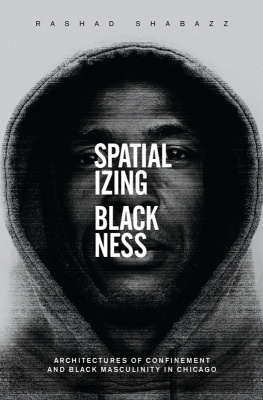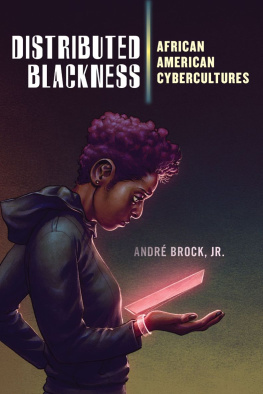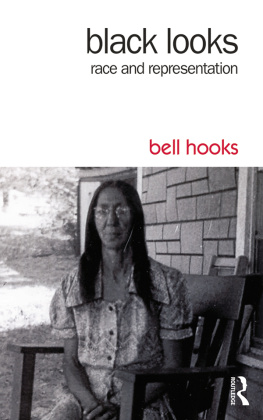Spatializing Blackness
THE NEW BLACK STUDIES SERIES
Edited by Darlene Clark Hine and Dwight A. McBride
A list of books in the series appears at the end of this book.
Spatializing Blackness
Architectures of Confinement
and Black Masculinity in Chicago
RASHAD SHABAZZ
UNIVERSITY OF ILLINOIS PRESS
Urbana, Chicago, and Springfield
2015 by the Board of Trustees
of the University of Illinois
All rights reserved
1 2 3 4 5 C P 5 4 3 2 1
 This book is printed on acid-free paper.
This book is printed on acid-free paper.
Library of Congress Cataloging-in-Publication Data
Shabazz, Rashad, 1976
Spatializing Blackness : architectures of confinement and Black
masculinity in Chicago / Rashad Shabazz.
pages cm. (New Black studies series)
Includes bibliographical references and index.
ISBN 978-0-252-03964-5 (hardback : acid-free paper)
ISBN 978-0-252-08114-9 (paper : acid-free paper)
ISBN 978-0-252-09773-7 (e-book)
1. African American menIllinoisChicagoSocial conditions20th century. 2. MasculinitySocial aspectsIllinoisChicagoHistory20th century. 3. African AmericansIllinoisChicagoSocial conditions20th century. 4. Architecture and societyIllinoisChicagoHistory20th century. 5. Space (Architecture)Social aspectsIllinoisChicagoHistory20th century. 6. Social controlIllinoisChicagoHistory20th century.
7. ImprisonmentSocial aspectsIllinoisChicagoHistory20th century. 8. Spatial behaviorSocial aspectsIllinoisChicagoHistory20th century. 9. Chicago (Ill.)Race relationsHistory20th century. 10. Chicago (Ill.)Geography.
I. Title.
F 548.9.N4S53 2015
305.38896073077311dc23 2015006779
Contents
Preface: Geographic Lessons
My most important geographic lessons did not come from a lecture in a classroom. They did not come from a book or an article. They came from growing up in Chicago.
I grew up on the South Side between the mid-1970s and the mid-1990s. I was raised in the city during a period of intense transition, part of the generation that brought hip-hop into the public and witnessed the election of the citys first Black mayor. I saw the impact exploding murder rates had on the city and experienced the growth and decline of gangs. I had the privilege of seeing the Chicago Bears win their first Super Bowl and had a front row seat to the ascendance of Michael Jordan and the six championships he brought our basketball-crazed city. I saw Black people move to the South Suburbs in droves and witnessed the early return of whites to the city.
My geographic lessons were largely informed by my family organization. My parents divorced when I was four. In the aftermath I lived with my great-grandparents while my mother, who was my primary parent, tried to figure out her next steps. My great-grandparents lived on 103rd Street and St. Lawrence Avenue near King Drive, in the Pullman neighborhood, made famous by the Pullman porters.
When I was in fourth grade my mother and I moved to Calumet Park, a village on the edge of the South Side, off 125th Street. This was my primary residence. Our move to Cal Park was an important one. It was the first home my mother owned. She moved us there because the schools were better than Chicagos and because it was a safer neighborhood. We moved there as the last few white families were leaving the neighborhood for whiter suburbs farther south. In fact, my mother bought the home we lived in from a white family. Whites moved to Calumet Park in the postWorld War II era. They were moving away from the expanding Black community on the South Side. And in the mid-1980s the children of those people were once again leaving because Blacks were moving in.
The Cal Park I grew up in was a working-class and middle-class Black community. It had good schools, a recreation center that served as the center of youth life, and a community pool. Our parents were first-time homeowners who grew up in the 1960s under de facto segregation.
I spent time also (to a much lesser degree than at my great-grandparents) at my fathers home, which was at 109th Street and Normal Avenue near South Halsted Street. His neighborhood was working class. City workers and retirees lived on the block, as well as young families and former prisoners.
From weekend to weekend, year after year, I visited my great-grandparents and my fathers home and saw vast differences between the neighborhoods. These trips taught me about geography. More than just streets and neighborhoods, my weekend-trip experiences taught me that where you were located in the city determined the kind of experiences you might have, food you might consume, and proximity to poverty, policing, or street violence. I learned that every neighborhood produced a set of experiences that informed the social, political, and cultural dynamics of the community and the people.
I received my first geographic lesson in Cal Park. The kids who grew up there, particularly the Black children, had extended family in other parts of the city. For many of us, the community we lived in and the places where our extended families lived were in contrast economically. For example, on 103rd Street, where my great-grandparents lived, poverty was more visible than it was in Cal Park; where my grandmother lived on 76th Street and Parnell Avenue, the poverty was even more apparent. By the late 1980s, there were shootings in my great-grandparents neighborhood. In 1990, my best friends big brother was killed by an assailants bullet. Two years later, a close friend from 103rd Street was shot to death while walking home from school. These experiences taught me that I had to be mindful of my actions in certain neighborhoods and not make universal claims about what a neighborhood was supposed to look and feel like. Even though I did not have to worry about gun violence in Cal Park, I did have to be mindful of police.
Weekends at my fathers house expanded my spatial awareness even more. He had friends all over the city. And every weekend I spent with him we visited them. We went everywhere: the far South Side, the West Side, South Suburbs; we went to Stony Island (where I was born), Roseland, Englewood, and downtown; we went to Bronzeville, to the Robert Taylor Housing Projects, and once or twice to the North Side. With my father, every weekend was a tour of the city.
Spatializing Blackness is the product of those geographic lessons I learned as a kid. I draw on them to understand the intersection of race, gender, and geography in Chicago. Rest assured, this book is not a collection of childhood memoriesscholarly research and analysis is the cornerstone of this project. Nevertheless, those early geographic lessons created the intellectual footprint from which this book emerged.
Acknowledgments
Spatializing Blackness would not have been possible without the unconditional support and help of many people. I want to acknowledge these family, friends, mentors, and allies.
This book began when I was in graduate school. I attended the History of Consciousness program at the University of California, Santa Cruz. His-Con (as we call it) provided me the intellectual space and freedom to bring to life the research during that period on which Spatializing Blackness is based. While there, I developed close relationships with several classmates. Sora Han, Greg Caldwell, NeEddra James, Paula Ioanide, Kalindi Vora, Kim Tallbear, Marco Mojica, and Felice Blake were an invaluable intellectual and emotional support system that enabled me to navigate the bewildering world of graduate school. The time I spent with them helped me to grow as a person and scholar. This book exists in part because of them.








 This book is printed on acid-free paper.
This book is printed on acid-free paper.